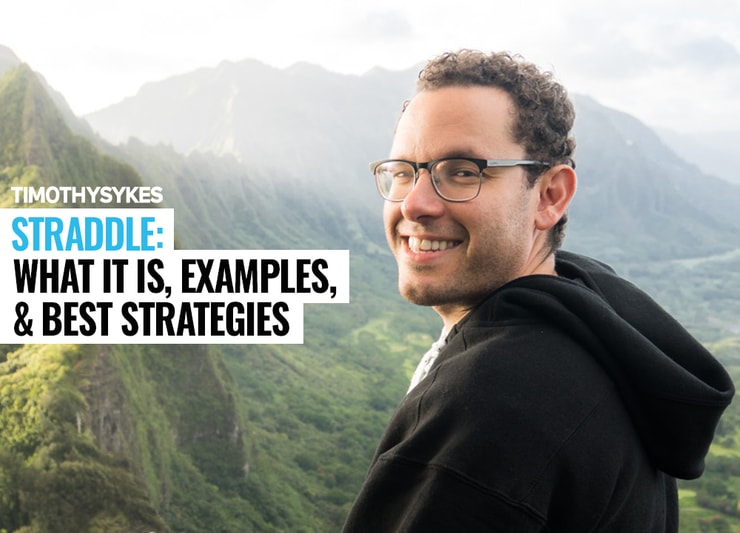The majority of the time, I only trade penny stocks, but today I want to talk about options straddles.
I know…
Some of you are like … “an options what?”
It can be confusing, which is why I think penny stocks are easier for new traders to understand. In penny stocks, there are fewer factors to consider, and my entire trading philosophy is to keep my strategy as simple as possible.
However, many of my students continually push the boundaries of their education and explore different areas of equities — including the options market. I have many successful students who use different strategies.
Before we dive in … let me be very clear — trading isn’t a get-rich-quick scheme.
Table of Contents
What’s a Straddle Option?

I’m a firm believer that there’s no one right way to trade, but I always trade with these rules. So when a few of my students started asking me about options, I thought I could make this a great learning opportunity for everyone.
One particular student was very interested in an options strategy called a straddle. This strategy can be confusing if you have little or no options experience.
When using the straddle, you buy both a call and a put option for an underlying security. These options must have the same strike price and the same expiration date. Otherwise, the strategy doesn’t work.
The point of buying both a call and a put option is to hedge your risk. Options are a very risky market, and this approach allows traders to protect themselves from significant losses.
There are two approaches to a straddle — the long straddle and short straddle.
Long Straddle
A long straddle doesn’t necessarily mean a trader believes a stock is going up. In this variation, the call and put options are purchased for the same strike and expiry. The owner of these options then profits when the underlying instruments price moves a long way from the strike price.
This move could be in either direction, which is why traders use this strategy on highly volatile stocks. The long straddle allows traders to minimize their risk but have unlimited profit potential as the stock continues to move away from the strike price.
Short Straddle
The opposite approach is called a short straddle. Instead of buying both a call and a put option, a trader using this strategy simultaneously sells a put and a call option for the same strike and expiry date.
This approach limits the potential upside to the premium the owner collects when selling the options.
However, the risk is unlimited … That means if a stock makes a large move away from the strike price, the owner will have a significant loss.
Contrary to a long straddle, investors use a short straddle on stocks that aren’t volatile. Many traders who use this strategy have a very high win rate but limit themselves to smaller wins.
More Breaking News
- Is GRAB on the Verge of a Breakout? Analyzing the Latest Market Moves
- Is Redfin’s Recent Performance Signaling a Market Shift or Just a Normal Bump?
- Marathon Digital Holdings: Is the Recent Crypto Dip a Buying Opportunity?
Straddle vs. Strangle Options
An essential characteristic of a straddle is that it’s non-directional. There’s no bias in mind when a trader enters a position. They’re either looking for a large move or no move at all — the direction doesn’t matter.
If a trader wants to use the same approach to minimize risk but has a bias in mind — a strangle is a better strategy.
For example, if an investor believes a stock will move in a positive direction, she’d buy call options for her estimated strike price but buy put options with a lower strike. This allows her to increase her profit potential (while also increasing her risk) because she believes the instrument will move in a specific direction.
Example of Straddle Options
OK … I know this can be confusing, so let’s go over an example.
I’ll make up a stock and some numbers to help simplify things. Let’s say you’re very interested in trading XYZ stock and leaning toward options because of its volatility … And you just learned a new options strategy called a straddle.
On December 11, 2019, let’s say XYZ closed at $1,748.72 a share.
As I previously explained, there are two different approaches to a straddle. For simplicity, imagine both call and put options cost $1.
Buying a Straddle

If you believe XYZ will make a large move in either direction, this is a good approach for you.
To properly buy a straddle, you need to buy both a call and put option, which will cost you $2. In this example, your risk is minimal. There’s no way for you to lose more than the $2 you used to buy the straddle.
However, if XYZ has an unexpected announcement that tanks the stock, the value of your options will increase dramatically.
The call option will become nearly worthless, but the put option could exponentially jump in value to $10 — it all depends on the size of the move. But it’s not uncommon for an option to move 1000% or more in a day.
In this theoretical example, there’s a fixed risk of $2, and you could make $10. Buying the straddle gave you a 5:1 return on your investment.
Selling a Straddle
Using the same numbers above, if you sell a straddle on XYZ, you’ll pocket $2 in premiums from selling one call and one put option. Again, selling a straddle is better for when you believe the underlying instrument won’t move outside a given range.
The risk and reward numbers are flipped when selling a straddle. The maximum profit on this straddle trade is $2. Typically, selling a straddle has a high win rate, but the risk to reward ratio isn’t ideal.
I always warn my students against strategies where risk is unlimited. You have to be extra careful.
Straddle Option Calculator
Calculating your risk and reward with option strategies can be very challenging. It’s much easier to make a mistake, especially when you consider the greek variables associated with options.
There are online calculators you can use to help you calculate risk, reward, and possible payouts when using a straddle strategy.
These calculators can help you select an instrument and choose the option with the best expiry and strike price for your needs. On most sites, you click a calculate button to generate a graph of returns at different prices up until the day of your straddle’s expiry.
Payout
A straddle’s payout can vary dramatically, which is why I strongly encourage you to use a straddle options calculator. There are a lot of factors that affect a straddle’s performance. A change in volatility, a price change, and time can dramatically change your returns.
Straddle Option Strategy

Unlike penny stocks, an option’s value can change due to several factors. It’s wise to consider the following factors when using a straddle option strategy…
Stock Price Change
Option values are tied to an underlying instrument, like a stock. Because an option is a contract for 100 shares of a stock, it’s highly susceptible to stock price moves. In other words, small movements in a stock price can create large swings in the option’s value.
Change in Volatility
Option market makers use a metric called implied volatility (IV) to calculate the price of an option. Highly volatile stocks like Facebook (NASDAQ: FB) or Netflix (NASDAQ: NFLX) have much higher IV levels than stocks that rarely make large moves.
When buying a straddle, it’s crucial that you look at an option’s IV value. If it’s high, you’ll have to pay more for the option. Then, if the IV drops because of the overall volatility in the market decreases, your option will lose value.
However, the same is true in reverse. If the market becomes more volatile, premiums on options will increase, and the value of your options will rise.
Impact of Time
When trading stocks, time isn’t usually a factor people consider. Sometimes trades last few hours or sometimes they last several months. It doesn’t cost additional money to hold a stock for an extended period.
With options, time is a factor. In the price of an option, there’s a theta value that represents the time value of the option. As the option gets closer to its strike price, the theta value decreases. That causes the value of your option to decrease as well.
Timing is everything when trading options, so don’t rush into a trade.
Early Assignment
The good news is when you enter into a straddle, you don’t have to hold until the strike date you selected. You can sell both the call and put option at any time on the open market, but you can also use an option’s early assignment to convert the option contracts into shares of the underlying security.
Often, it’s not ideal to exercise options with early assignment.
But if you use the short straddle strategy, you’re susceptible to early assignment at any time. Since you don’t own the option yourself, the individual you sold the option to can use early assignment. Whether the owner profits or not, it’s their right. That can result in an unanticipated loss for the option seller.
Swaption Straddle
Although you’ll probably never use a swaption, I want you to be aware of swaption straddles.
Many large banks and hedge funds use a swaption to manage interest rate risk. These institutions are highly susceptible to changes in interest rates, so they enter swaptions to remove unexpected changes in rates over a given period.
The swaption allows banks to calculate their books with a fixed value instead of one that’s ever-changing. Interest rates could drop, which would result in banks paying a higher rate they previously agreed.
But in the event that rates spike, they capitalize on the swaption straddle to reduce expenses.
Is a Straddle a Good Strategy?

In general, options can be complicated and confusing for the average investor. Like any strategy, it takes time to learn and master.
That said — I’m not a big fan of a short straddle.
The most important lesson I teach my students in my Trading Challenge is risk management. On any given trade, the risk should be two to three times smaller than the potential reward. With a short straddle, the risk is unlimited.
But a long straddle can be a good strategy. The risk is finite, with huge profit potential.
Straddle Risk
In trading, there’s always risk. It’s the name of the game.
Never risk more money than you can afford to lose. If you’re learning about this strategy, start slowly. Odds are it will take time to understand this strategy.
There’s always a learning curve with any new approach. Make sure you fully understand this strategy before you put money on the line.
Profit/Loss
If you quickly search online for “straddle options profits,” you’ll see thousands of examples of the immense profits out there. Unlike penny stocks, options can support much larger accounts. So it can seem like professional traders stand to make big gains…
But don’t ever assume that you can make those kinds of profits quickly — or ever. For a lot of options traders, it took years to reach those kinds of profits. And you don’t necessarily see the large losses those same traders took before they reached profit level.
Is it possible to make money with a straddle? Sure — I’ve seen people do it. It just won’t happen overnight, especially if you trade with a small account.
Conclusion
Personally, I’ll probably never use a straddle.
The strategy is more complicated than the ones I teach my students and confusing for new traders.
Is the profit potential there? Absolutely.
There’s no denying this strategy can work, but it’s risky — especially for the average newbie.
My advice: if you’re just beginning your trading journey, start with a more straightforward strategy. The straddle will always be there. Learn market and trading fundamentals first. You can start with my Trading Challenge. Apply today … but only if you’re really ready to work.
Tell me what you think of this post … Leave a comment below!



Leave a reply